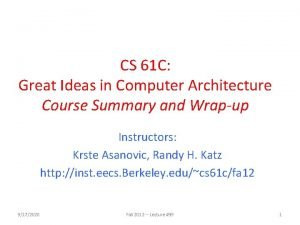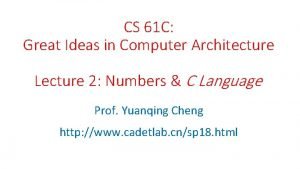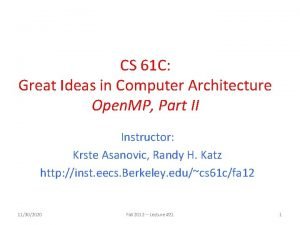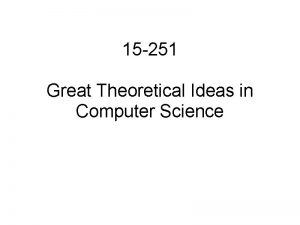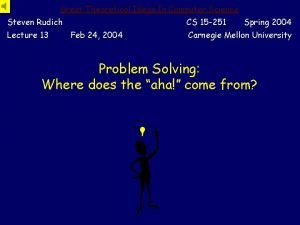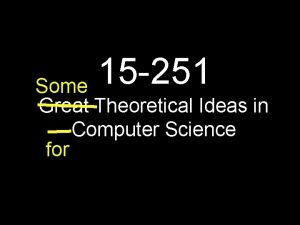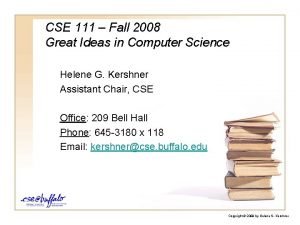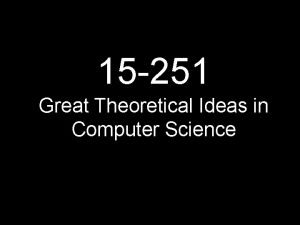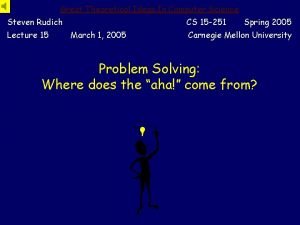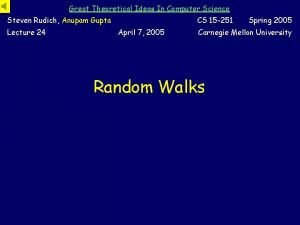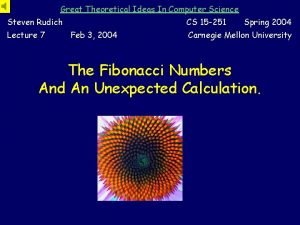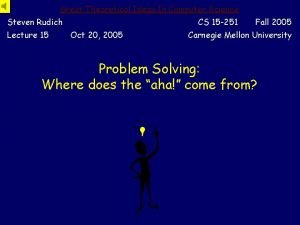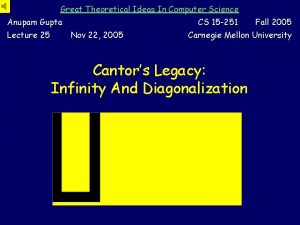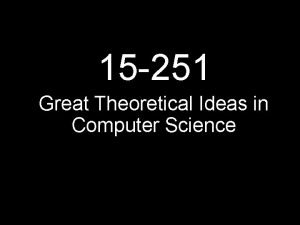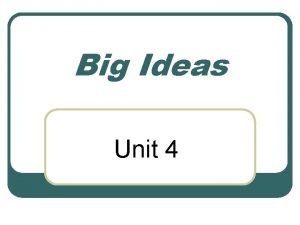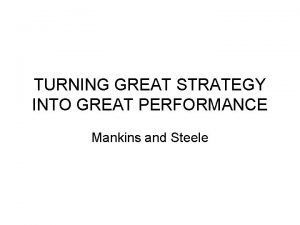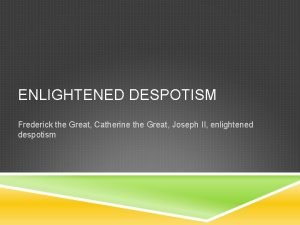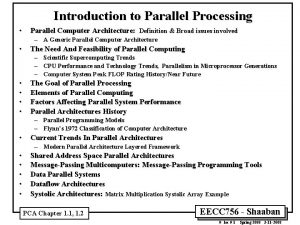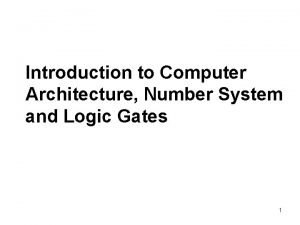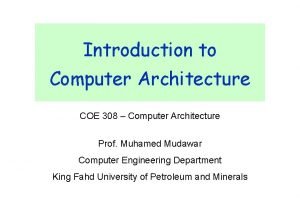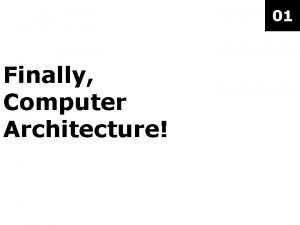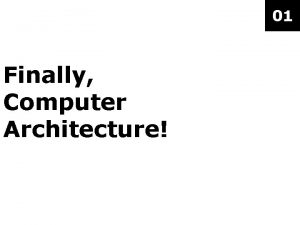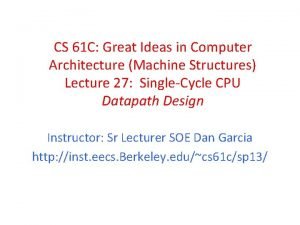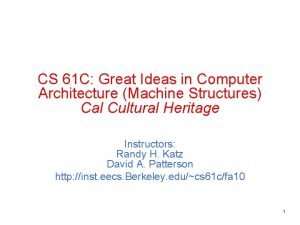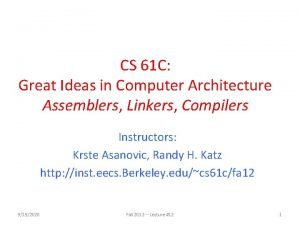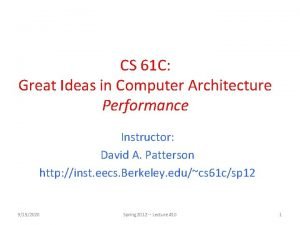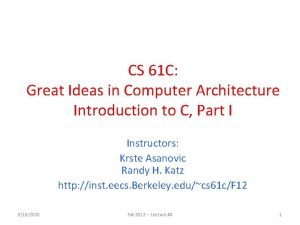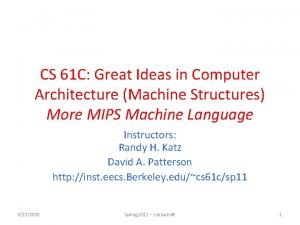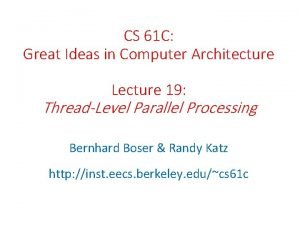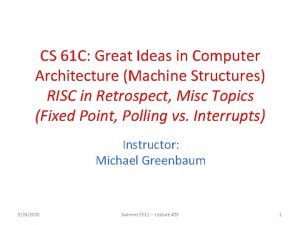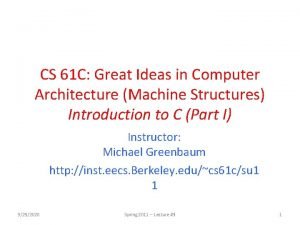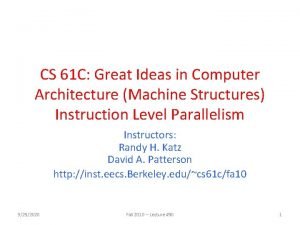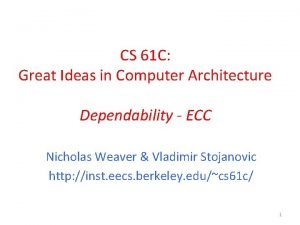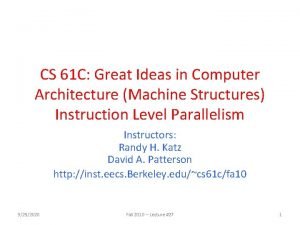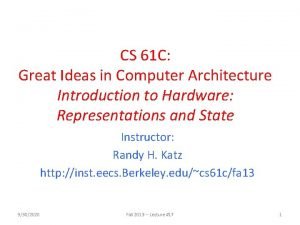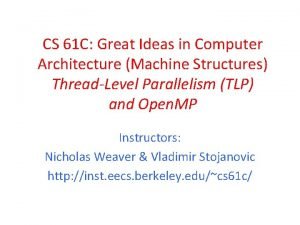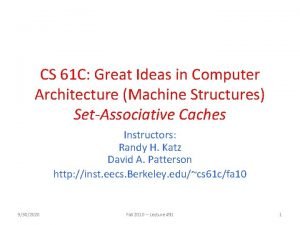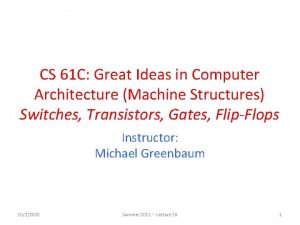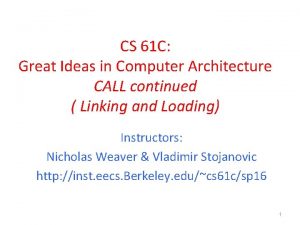CS 61 C Great Ideas in Computer Architecture



























































- Slides: 59

CS 61 C: Great Ideas in Computer Architecture Course Summary and Wrap Instructors: John Wawrzynek & Vladimir Stojanovic http: //inst. eecs. berkeley. edu/~cs 61 c/ 1

Old Machine Structures Application (ex: browser) Compiler Software Hardware Assembler Processor Operating System (Mac OSX) Memory I/O system CS 61 c Instruction Set Architecture Datapath & Control Digital Design Circuit Design transistors 2

New-School Machine Structures (It’s a bit more complicated!) Project 1 Software • Parallel Requests Assigned to computer e. g. , Search “Katz” • Parallel Threads Assigned to core e. g. , Lookup, Ads Hardware Leverage Parallelism & Achieve High Performance • Parallel Instructions >1 instruction @ one time e. g. , 5 pipelined instructions • Parallel Data >1 data item @ one time e. g. , Add of 4 pairs of words • Hardware descriptions All gates functioning in parallel at same time • Programming Languages Smart Phone Warehouse Scale Computer Project 2 Computer … Core Memory Input/Output Instruction Unit(s) Project 3 Core Functional Unit(s) A 0+B 0 A 1+B 1 A 2+B 2 A 3+B 3 Cache Memory Logic Gates Project 3 4

New School CS 61 C (1/2) Personal Mobile Devices 4

New School CS 61 C (2/3) 5

New School CS 61 C (3/3) 6

CS 61 c is NOT about C Programming • It’s about the hardware-software interface – What does the programmer need to know to achieve the highest possible performance • C Language is close to the underlying hardware, unlike languages like Python! – Allows us to talk about key hardware features in higher level terms – Allows programmer to explicitly harness underlying hardware parallelism for high performance: “programming for performance” 7

Great Ideas in Computer Architecture 1. 2. 3. 4. 5. 6. Design for Moore’s Law Abstraction to Simplify Design Make the Common Case Fast Dependability via Redundancy Memory Hierarchy Performance via Parallelism/Pipelining/Prediction 8

Powers of Ten inspired 61 C Overview • Going Top Down cover 3 Views 1. Architecture (when possible) 2. Physical Implementation of that architecture 3. Programming system for that architecture and implementation (when possible) See https: //www. youtube. com/watch? v=0 f. KBhv. Djuy 0 1977 Short “Film Dealing with the relative size of things in the universe, and the effect of adding another zero. “ 9

Earth 107 meters 10

The Dalles, Oregon 104 meters 11

The Dalles, Oregon 104 meters 12

Google’s Oregon WSC 103 meters 13

10 kilometers Google’s Oregon WSC 102 meters 104 meters 103 meters 14

Google Warehouse • 90 meters by 75 meters, 10 Megawatts • Contains 40, 000 servers, 190, 000 disks • Power Utilization Effectiveness: 1. 23 – 85% of 0. 23 overhead goes to cooling losses – 15% of 0. 23 overhead goes to power losses • Contains 45, 40 -foot long containers – 8 feet x 9. 5 feet x 40 feet • 30 stacked as double layer, 15 as single layer 15

100 meters Containers in WSCs 102 meters 16

Google Container 101 meters 17

10 meters Google Container 100 meters • 2 long rows, each with 29 racks • Cooling below raised floor • Hot air returned behind racks 18

Equipment Inside a Container Server (in rack format): 7 foot Rack: servers + Ethernet local area network switch in middle (“rack switch”) Array (aka cluster): server racks + larger local area network switch (“array switch”) 10 X faster => cost 100 X: cost f(N 2) 19

1 meter Google Rack 100 meters • Google rack with 20 servers + Network Switch in the middle • Array switches connect to racks via multiple 1 Gbit/s links • 2 datacenter routers connect to array switches over 10 Gbit/s links 20

Programming WSC: Word Count in Spark’s Python API // RDD: (Resilient Distributed Dataset) // Spark’s primary abstraction of a distributed collection of items file = sc. text. File(“hdfs: //…”) // Two kinds of operations: // Actions: RDD Value // Transformations: RDD // e. g. flat. Map, reduce. By. Key file. flat. Map(lambda line: line. split()). map(lambda word: (word, 1)). reduce. By. Key(lambda a, b: a + b) 21

Great Ideas in Computer Architecture 1. Design for Moore’s Law -- WSC, Container, Rack 2. Abstraction to Simplify Design 3. Make the Common Case Fast 4. Dependability via Redundancy -- Multiple WSCs, Multiple Racks, Multiple Switches 5. Memory Hierarchy 6. Performance via Parallelism/Pipelining/Prediction -- Task level Parallelism, Data Level Parallelism 22

Google Server Internals 10 -1 meters 10 centimeters Google Server 23

Google Board Details • Supplies only 12 volts • Battery per board vs. large battery room – Improves PUE: 99. 99% efficient local battery vs. 94% for battery room • 2 SATA Disk Drives – 1 Terabyte capacity each – 3. 5 inch disk drive – 7200 RPM • 2 AMD Opteron Microprocessors – Dual Core, 2. 2 GHz • 8 DIMMs – 8 GB DDR 2 DRAM • 1 Gbit/sec Ethernet Network Interface 24

Programming Multicore Microprocessor: Open. MP #include <omp. h> #include <stdio. h> static long num_steps = 100000; int value[num_steps]; int reduce() { int i; int sum = 0; #pragma omp parallel for private(x) reduction(+: sum) for (i=1; i<= num_steps; i++){ sum = sum + value[i]; } } 25

Great Ideas in Computer Architecture 1. Design for Moore’s Law -- More transistors = Multicore + SIMD 2. Abstraction to Simplify Design 3. Make the Common Case Fast 4. Dependability via Redundancy 5. Memory Hierarchy -- More transistors = Cache Memories 6. Performance via Parallelism/Pipelining/ Prediction -- Thread-level Parallelism 26

10 -2 meters centimeters AMD Opteron Microprocessor 27

AMD Opteron Microarchitecture 72 physical registers 28

AMD Opteron Pipeline Flow • For integer operations − 12 stages (Floating Point is 17 stages) − Up to 106 RISC-ops in progress 29

AMD Opteron Block Diagram L 1 Icache 64 B Branch Prediction Fetch Scan/Align/Decode Fastpath Microcode Engine µops L 1 Dcache 64 KB Instruction Control Unit (72 entries) Int Decode & Rename FP Decode & Rename 44 -entry Load/Store Queue Res Res 36 -entry FP scheduler AGU AGU FADD ALU ALU FMUL FMISC MULT 30

10 -2 meters centimeters AMD Opteron Microprocessor 31

millimeters AMD Opteron Core 10 -3 meters 32

Programming One Core: C with Intrinsics void mmult(int n, float *A, float *B, float *C) { for ( int i = 0; i < n; i+=4 ) for ( int j = 0; j < n; j++ ) { __m 128 c 0 = _mm_load_ps(C+i+j*n); for( int k = 0; k < n; k++ ) c 0 = _mm_add_ps(c 0, _mm_mul_ps(_mm_load_ps(A+i+k*n), _mm_load 1_ps(B+k+j*n))); _mm_store_ps(C+i+j*n, c 0); } }

Inner loop from gcc –O -S Assembly snippet from innermost loop: movaps (%rax), %xmm 9 mulps %xmm 0, %xmm 9 addps %xmm 9, %xmm 8 movaps 16(%rax), %xmm 9 mulps %xmm 0, %xmm 9 addps %xmm 9, %xmm 7 movaps 32(%rax), %xmm 9 mulps %xmm 0, %xmm 9 addps %xmm 9, %xmm 6 movaps 48(%rax), %xmm 9 mulps %xmm 0, %xmm 9 addps %xmm 9, %xmm 5

Great Ideas in Computer Architecture 1. Design for Moore’s Law 2. Abstraction to Simplify Design 3. 4. 5. 6. -- Instruction Set Architecture, Micro-operations Make the Common Case Fast Dependability via Redundancy Memory Hierarchy Performance via Parallelism/Pipelining/Prediction -- Instruction-level Parallelism (superscalar, pipelining) -- Data-level Parallelism 35

SIMD Adder • Four 32 -bit adders that operate in parallel – Data Level Parallelism 36

One 32 -bit Adder 37

1 bit of 32 -bit Adder 38

Complementary MOS Transistors (NMOS and PMOS) of NAND Gate X 3 v Y NAND gate Z 0 v x y z 0 volts 3 volts 3 volts 0 volts 39

10 -7 meters 100 nanometers Physical Layout of NAND Gate 40

10 -7 meters 100 nanometers Scanning Electron Microscope Top View Cross Section 41

10 -6 meters Block Diagram of Static RAM 42

1 Bit SRAM in 6 Transistors 43

10 -7 meters 100 nanometers Physical Layout of SRAM Bit 44

100 nanometers SRAM Cross Section 10 -7 meters 45

DIMM Module • DDR = Double Data Rate – Transfers bits on Falling AND Rising Clock Edge • Has Single Error Correcting, Double Error Detecting Redundancy (SEC/DED) – 72 bits to store 64 bits of data – Uses “Chip kill” organization so that if single DRAM chip fails can still detect failure • Average server has 22, 000 correctable errors and 1 uncorrectable error per year 46

1 micron DRAM Bits 10 -6 meters 47

DRAM Cell in Transistors 48

Physical Layout of DRAM Bit 49

10 -7 meters 100 nanometers Cross Section of DRAM Bits 50

AMD Dependability • L 1 cache data is SEC/DED protected • L 2 cache and tags are SEC/DED protected • DRAM is SEC/DED protected with chipkill • On-chip and off-chip ECC protected arrays include autonomous, background hardware scrubbers • Remaining arrays are parity protected – Instruction cache, tags and TLBs 51

Programming Memory Hierarchy: Cache Blocked Algorithm • The blocked version of the i-j-k algorithm is written simply as (A, B, C are submatricies of a, b, c) for (i=0; i<N/r; i++) for (j=0; j<N/r; j++) for (k=0; k<N/r; k++) C[i][j] += A[i][k]*B[k][j] – r = block (sub-matrix) size (Assume r divides N) – X[i][j] = a sub-matrix of X, defined by block row i and block column j

Great Ideas in Computer Architecture 1. Design for Moore’s Law -- Higher capacities caches and DRAM 2. Abstraction to Simplify Design 3. Make the Common Case Fast 4. Dependability via Redundancy -- Parity, SEC/DEC 5. Memory Hierarchy -- Caches, TLBs 6. Performance via Parallelism/Pipelining/Prediction -- Data-level Parallelism 53

Course Summary • As the field changes, cs 61 c had to change too! • It is still about the software-hardware interface – Programming for performance! – Parallelism: Task-, Thread-, Instruction-, and Data. Map. Reduce, Open. MP, C, SSE instrinsics – Understanding the memory hierarchy and its impact on application performance • Interviewers ask what you did this semester! 54

Administrivia • Get labs checked off this week – save OH for exam questions • Final Exam – FRIDAY, DEC 18, 2015, 7 -10 P – Location: Wheeler Aud (with overflow room) – THREE cheat sheets (MT 1, MT 2, post-MT 2) • Review Sessions: – Thursday Dec 10 2 -5 pm, room TBA – HKN: TBA – Regular office hours next week – but check piazza for changes 55

Competition Prize Presentation 56

What Next? • EECS 151 (spring/fall) if you liked digital systems design • CS 152 (fall) if you liked computer architecture • CS 162 (spring/fall) operating systems and system programming • CS 168 computer networks 57

The Future for Future Cal Alumni • What’s The Future? • Many New Opportunities: Parallelism, Cloud, Statistics + CS, Bio + CS, Society (Health Care, 3 rd world) + CS • Cal heritage as future alumni – Hard Working / Can do attitude – Never Give Up (“Don’t fall with the ball!”) • “The best way to predict the future is to invent it” – Alan Kay (inventor of personal computing vision) • Future is up to you! 58

Thanks to all Staff! • • • • TAs: William Huang (Head TA) Fred Hong (Head TA) Derek Ahmed Rebecca Herman Jason Zhang Chris Hsu Shreyas Chand David Adams Xinghua Dou Eric Lin Manu Goyal Stephan Liu Austin Tai Alex Khodaverdian • • Tutors: Marta Lokhava Brenton Chu Shu Li Angel Lim Michelle Tsai Dasheng Chen • Readers: • Daylen Yang • Molly Zhai • + All the Lab assistants 59
 8 ideas of computer architecture
8 ideas of computer architecture Task level parallelism
Task level parallelism 8 great ideas in computer architecture
8 great ideas in computer architecture 8 great ideas in computer architecture
8 great ideas in computer architecture Great theoretical ideas in computer science
Great theoretical ideas in computer science Great theoretical ideas in computer science
Great theoretical ideas in computer science Great theoretical ideas in computer science
Great theoretical ideas in computer science Cse 111
Cse 111 Great theoretical ideas in computer science
Great theoretical ideas in computer science Great theoretical ideas in computer science
Great theoretical ideas in computer science Great theoretical ideas in computer science
Great theoretical ideas in computer science Steven rudich
Steven rudich Vocabularize
Vocabularize Great theoretical ideas in computer science
Great theoretical ideas in computer science Great theoretical ideas in computer science
Great theoretical ideas in computer science Buses in computer architecture
Buses in computer architecture Difference computer organization and architecture
Difference computer organization and architecture Fgi and fgo in computer architecture
Fgi and fgo in computer architecture Ideas have consequences bad ideas have victims
Ideas have consequences bad ideas have victims Que son las ideas complementarias
Que son las ideas complementarias Unit 4 great ideas
Unit 4 great ideas Turning great strategy into great performance
Turning great strategy into great performance South dakota state animal
South dakota state animal With great power comes great responsibility voltaire
With great power comes great responsibility voltaire Great white shark vs great hammerhead
Great white shark vs great hammerhead Does alexander the great deserve his title
Does alexander the great deserve his title Frederick the great education
Frederick the great education With great expectations comes great responsibility
With great expectations comes great responsibility A great deal vs a great many
A great deal vs a great many With great power comes great responsibility batman
With great power comes great responsibility batman Does alexander deserve to be called the great
Does alexander deserve to be called the great Great is thy faithfulness o lord my father
Great is thy faithfulness o lord my father Explain architecture business cycle
Explain architecture business cycle Call and return architecture
Call and return architecture Modular architecture vs integrated architecture
Modular architecture vs integrated architecture Fundamental and incidental interactions
Fundamental and incidental interactions Computer organization and architecture 10th solution
Computer organization and architecture 10th solution Computer architecture 101
Computer architecture 101 Computer organization lab experiments
Computer organization lab experiments Introduction to computer organization and architecture
Introduction to computer organization and architecture Timing and control in computer architecture
Timing and control in computer architecture Evolution of computer architecture
Evolution of computer architecture Programmed i/o in computer architecture
Programmed i/o in computer architecture Fp adder
Fp adder Addressing mode in computer architecture
Addressing mode in computer architecture Chordal ring
Chordal ring Smt computer architecture
Smt computer architecture Mips mul
Mips mul Collision prevention in computer architecture
Collision prevention in computer architecture Instruction format in computer architecture
Instruction format in computer architecture Nano programming in coa
Nano programming in coa A micro program sequencer
A micro program sequencer Memory system design in computer architecture
Memory system design in computer architecture Memory hierarchy
Memory hierarchy Non linear pipeline processor
Non linear pipeline processor Computer architecture definition
Computer architecture definition Parallel processing definition
Parallel processing definition Architect of the concept of number system
Architect of the concept of number system What is computer architecture
What is computer architecture Types of isa in computer architecture
Types of isa in computer architecture

